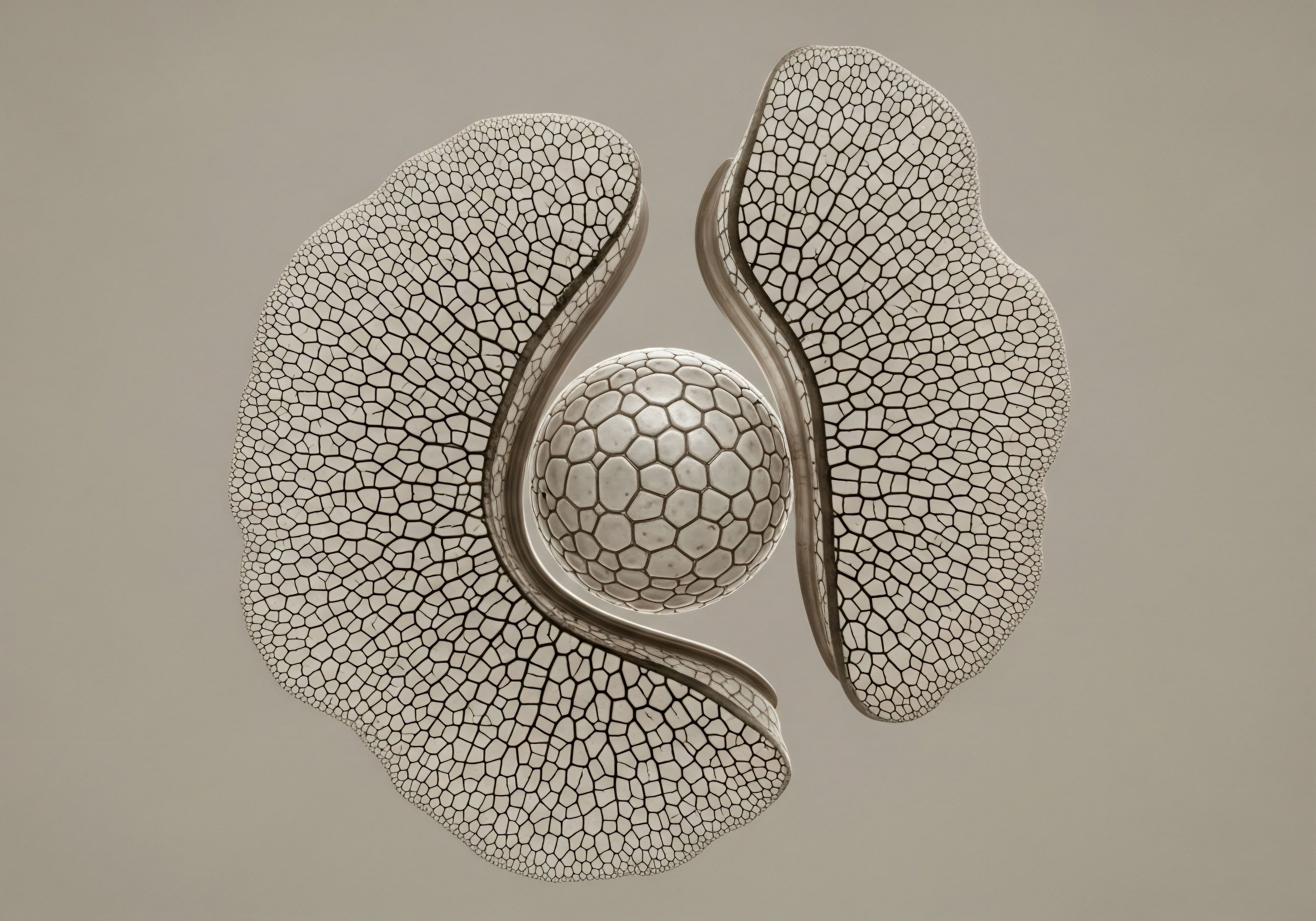

Fundamentals
Perhaps you have felt it ∞ a subtle shift in your body’s rhythm, a persistent fatigue that resists rest, or a growing difficulty in managing your weight despite earnest efforts. These experiences, often dismissed as simply “getting older” or “stress,” can signal a deeper conversation happening within your biological systems.
Your body communicates through a complex network of chemical messengers, and when these signals become distorted, the impact can be felt across your entire being. Understanding these internal dialogues marks the first step toward reclaiming your vitality and function.
At the heart of many such metabolic challenges lies a condition known as insulin resistance. Imagine insulin as a key, designed to unlock your cells, allowing glucose ∞ your body’s primary fuel source ∞ to enter and provide energy. When cells become resistant, this key no longer works as effectively.
The cells resist glucose uptake, leading to higher levels of both glucose and insulin circulating in your bloodstream. This persistent elevation of insulin, known as hyperinsulinemia, is not merely a number on a lab report; it represents a system working harder and harder to achieve a diminishing return, ultimately straining your metabolic capacity.
This state of cellular unresponsiveness has wide-ranging consequences beyond blood sugar regulation. It influences how your body stores fat, how your energy levels fluctuate, and even how your other endocrine glands operate. Over time, this sustained metabolic stress can contribute to a spectrum of health concerns, including weight gain, persistent tiredness, and even an increased risk for more serious conditions. Recognizing these early signals and understanding their biological underpinnings provides a pathway to proactive health management.
Insulin resistance describes a state where cells respond less effectively to insulin, leading to elevated blood glucose and insulin levels.

How Does Insulin Influence Your Body’s Fuel Use?
Insulin, a peptide hormone produced by the pancreatic beta cells, plays a central role in carbohydrate metabolism. After consuming food, particularly carbohydrates, glucose enters your bloodstream. In response, your pancreas releases insulin. Insulin then signals liver cells, fat cells, and striated muscle cells to absorb and metabolize this glucose.
This action helps lower blood glucose concentrations, maintaining a stable internal environment. When cells become resistant, they do not absorb glucose efficiently, leaving more glucose in the blood and prompting the pancreas to produce even more insulin in an attempt to normalize blood sugar.
The body’s glucose levels are a delicate balance between glucose entering the circulation from food or liver production, and glucose leaving the circulation to be used by cells or stored. Glucagon, another pancreatic hormone, acts in opposition to insulin, raising blood glucose levels when they fall too low by stimulating the liver to release stored glucose. This intricate interplay between insulin and glucagon, alongside other hormones, ensures your body has a consistent energy supply.

Lifestyle Interventions as Foundational Support
Addressing insulin resistance begins with foundational lifestyle modifications. These interventions are not simply about weight loss; they are about recalibrating your body’s metabolic signaling. Nutritional adjustments, such as reducing calorie intake and selecting carbohydrates that do not provoke excessive insulin demands, represent a primary treatment approach. Physical activity, particularly moderate-intensity cardiovascular exercise, significantly improves skeletal muscle insulin sensitivity and increases energy expenditure.
The benefits of regular movement extend beyond calorie burning. Exercise directly enhances the ability of muscle cells to take up glucose, even without optimal insulin signaling. This makes physical activity a powerful tool in restoring metabolic balance. Sustainable behavioral adjustments, including consistent physical activity and mindful eating patterns, form the bedrock for long-term metabolic health. These changes are not quick fixes; they represent a sustained commitment to supporting your body’s innate capacity for wellness.


Intermediate
While lifestyle adjustments are undeniably powerful and represent the first line of action, some individuals find that their biological systems require additional, targeted support to fully recalibrate. This is where personalized wellness protocols, grounded in a deep understanding of endocrine function, become relevant. These approaches aim to address underlying hormonal imbalances that may perpetuate insulin resistance or hinder metabolic recovery, working in concert with a healthy lifestyle.

Testosterone Optimization Protocols
Testosterone, often considered a male hormone, plays a significant role in metabolic health for both men and women. Low testosterone levels in men have associations with insulin resistance, increased visceral adiposity, and metabolic syndrome. Targeted testosterone replacement therapy (TRT) can improve insulin sensitivity and glucose regulation in hypogonadal men. Studies indicate that TRT can reduce the HOMA index, a measure of insulin resistance, and lower fasting blood glucose and glycated hemoglobin levels.
For men, a standard protocol might involve weekly intramuscular injections of Testosterone Cypionate. To maintain natural testosterone production and fertility, Gonadorelin, a gonadotropin-releasing hormone (GnRH) analog, may be administered via subcutaneous injections twice weekly. Gonadorelin stimulates the pituitary gland to release luteinizing hormone (LH) and follicle-stimulating hormone (FSH), which in turn signal the testes to produce testosterone.
To manage potential estrogen conversion from testosterone, an oral tablet of Anastrozole, an aromatase inhibitor, might be included twice weekly. Anastrozole works by blocking the enzyme aromatase, which converts androgens into estrogens. Some protocols also incorporate Enclomiphene to further support LH and FSH levels, particularly for fertility preservation or post-TRT recovery.
Women also experience symptoms related to low testosterone, including irregular cycles, mood changes, hot flashes, and reduced libido. For pre-menopausal, peri-menopausal, and post-menopausal women, testosterone optimization can be a component of a broader hormonal balance strategy. Protocols typically involve lower doses of Testosterone Cypionate, often 10 ∞ 20 units (0.1 ∞ 0.2ml) weekly via subcutaneous injection.
Progesterone is prescribed based on menopausal status, playing a role in menstrual cycle regulation and overall hormonal equilibrium. While estrogen and progesterone levels fluctuate naturally, higher levels of both, particularly progesterone during the luteal phase, can temporarily increase insulin resistance. Pellet therapy, offering long-acting testosterone, can also be an option, with Anastrozole considered when appropriate to manage estrogen levels.
Testosterone optimization can improve insulin sensitivity and metabolic markers in individuals with low levels.

Growth Hormone Peptide Therapy
Beyond sex hormones, other signaling molecules, known as peptides, hold significant promise for metabolic health and overall vitality. Growth hormone peptide therapy aims to stimulate the body’s natural production of growth hormone (GH), which plays a role in metabolism, body composition, and tissue repair. These peptides are not direct growth hormone replacements; they encourage the pituitary gland to release more of its own GH.
Key peptides in this category include ∞
- Sermorelin ∞ A synthetic analog of growth hormone-releasing hormone (GHRH), Sermorelin stimulates the pituitary gland to secrete human growth hormone. It can support lean body mass and insulin sensitivity.
- Ipamorelin / CJC-1295 ∞ Ipamorelin is a selective growth hormone secretagogue that promotes GH release with minimal impact on other hormones like cortisol or prolactin.
CJC-1295 is a modified GHRH analog with a longer duration of action. When combined, they can significantly increase GH levels, supporting muscle gain, fat reduction, and improved recovery.
- Tesamorelin ∞ This peptide specifically targets abdominal fat accumulation and can enhance body composition, insulin sensitivity, and cardiovascular health.
- Hexarelin ∞ A synthetic growth hormone-releasing peptide (GHRP), Hexarelin stimulates GH release, contributing to increased muscle mass, reduced fat mass, and improved injury recovery.
- MK-677 (Ibutamoren) ∞ While not a peptide, MK-677 mimics ghrelin and stimulates GH and IGF-1 secretion. It is used for increasing appetite, improving sleep, enhancing recovery, and promoting muscle growth.
These peptides offer a targeted approach to supporting metabolic function, particularly for active adults and athletes seeking to optimize body composition, improve recovery, and address age-related declines in growth hormone levels.

Other Targeted Peptides for Well-Being
The realm of peptides extends to other areas of well-being that indirectly support metabolic health by addressing related concerns.
- PT-141 (Bremelanotide) ∞ This peptide acts on melanocortin receptors in the brain to support sexual health, addressing concerns like low libido.
While its primary action is not metabolic, sexual health is an integral component of overall vitality and quality of life, which can be impacted by metabolic imbalances.
- Pentadeca Arginate (PDA) ∞ A synthetic peptide, PDA is recognized for its regenerative and healing properties. It supports tissue repair, reduces inflammation, and aids in recovery from injuries. By promoting cellular health and resilience, PDA contributes to overall physical function, which is foundational for maintaining an active lifestyle that supports metabolic balance.
These specialized peptides represent a frontier in personalized wellness, offering precise tools to address specific physiological needs that, when met, contribute to a more resilient and responsive biological system.
| Hormone/Peptide Class | Primary Action | Metabolic Relevance |
|---|---|---|
| Testosterone (Men) | Stimulates muscle growth, bone density, libido | Improves insulin sensitivity, reduces visceral fat |
| Testosterone (Women) | Supports bone density, libido, mood | Can influence body composition, energy regulation |
| Growth Hormone Peptides | Stimulate natural GH release | Enhance fat reduction, muscle growth, insulin sensitivity |
| PT-141 | Acts on brain receptors for sexual arousal | Supports overall well-being, indirectly aiding active lifestyle |
| Pentadeca Arginate | Promotes tissue repair, reduces inflammation | Supports physical recovery, enabling consistent activity |


Academic
Moving beyond the foundational and intermediate applications, a deeper exploration into the cellular and molecular underpinnings of insulin resistance reveals a complex interplay of biological axes and metabolic pathways. The question of whether lifestyle changes alone can fully reverse insulin resistance requires a precise understanding of these intricate mechanisms and the points at which targeted interventions can provide synergistic effects.

Cellular Mechanisms of Insulin Resistance
At the cellular level, insulin resistance manifests as impaired signaling within target tissues, primarily the liver, skeletal muscle, and adipose tissue. When insulin binds to its receptor on the cell surface, it initiates a cascade of intracellular events, leading to the translocation of glucose transporters (like GLUT4 in muscle and fat cells) to the cell membrane.
This allows glucose to enter the cell. In insulin-resistant states, defects can occur at various points along this signaling pathway, including impaired insulin receptor function, post-receptor signaling abnormalities, and altered glucose transporter activity.
The accumulation of ectopic fat ∞ triglycerides stored in non-adipose tissues such as the liver and skeletal muscle ∞ is a significant contributor to insulin resistance. While triglycerides themselves are not the direct cause, the accumulation of lipid metabolism intermediates within these organs disrupts metabolic processes.
This disruption can lead to lipotoxicity, inflammation, and oxidative stress, all of which impair insulin signaling. Lifestyle interventions, particularly diet-induced weight reduction and exercise, have demonstrated efficacy in reducing ectopic fat depositions, thereby improving cellular insulin responsiveness.
Insulin resistance involves complex cellular signaling defects and ectopic fat accumulation, hindering glucose uptake.

Endocrine System Interconnectedness and Metabolic Impact
The endocrine system operates as a finely tuned orchestra, where the activity of one hormone influences many others. Insulin resistance is not an isolated phenomenon; it is deeply intertwined with the function of the hypothalamic-pituitary-gonadal (HPG) axis and other hormonal systems.

Gonadal Hormones and Glucose Homeostasis
Sex hormones, including testosterone, estrogen, and progesterone, significantly influence glucose metabolism. In men, low testosterone levels are associated with reduced insulin sensitivity and an increased risk of type 2 diabetes. Testosterone appears to play a role in regulating glucose uptake in muscle and adipose tissue, and its deficiency can contribute to visceral fat accumulation, which further exacerbates insulin resistance. Clinical trials have shown that testosterone replacement can improve insulin sensitivity and metabolic markers in hypogonadal men, particularly those with type 2 diabetes.
For women, the relationship between sex hormones and insulin sensitivity is dynamic and influenced by menstrual cycle phases and menopausal status. Estrogen generally appears to enhance insulin sensitivity, while progesterone can temporarily induce a state of insulin resistance, particularly during the luteal phase of the menstrual cycle or in pregnancy.
This suggests that the balance and absolute levels of these hormones contribute to an individual’s metabolic profile. Protocols involving precise management of estrogen and progesterone, such as those used in female hormone balance, consider these effects to optimize overall metabolic health.

Growth Hormone Axis and Insulin Sensitivity
The growth hormone (GH) axis also plays a complex role in metabolic regulation. While GH is anabolic, promoting protein synthesis and muscle growth, it can also have diabetogenic effects, particularly at supraphysiological levels or in conditions of GH excess. GH increases insulin secretion and glucose uptake, but conversely, a GH-deficient state can be characterized by enhanced insulin sensitivity. GH-induced lipolysis, especially in visceral tissues, can increase free fatty acids, which interfere with insulin signaling pathways.
Therapeutic peptides like Sermorelin and CJC-1295, which stimulate endogenous GH release, aim to achieve physiological increases in GH and IGF-1, thereby supporting lean body mass and fat reduction without the adverse metabolic effects associated with exogenous GH administration. Tesamorelin, specifically, has demonstrated efficacy in reducing abdominal fat and improving insulin sensitivity, particularly in conditions like HIV-associated lipodystrophy.
Hormonal systems, including sex hormones and growth hormone, intricately influence insulin sensitivity and metabolic health.

Can Lifestyle Changes Alone Reverse Insulin Resistance? a Deeper Look?
The question of whether lifestyle changes alone can fully reverse insulin resistance is multifaceted. Evidence from programs like the Diabetes Prevention Program (DPP) unequivocally demonstrates that intensive lifestyle interventions, including dietary adjustments and increased physical activity, can significantly reduce the onset of type 2 diabetes in high-risk individuals, often by improving insulin sensitivity. A 7% weight reduction, for example, has been shown to reduce the onset of type 2 diabetes by 58%.
However, the degree of reversal and the long-term sustainability of lifestyle changes can vary significantly among individuals. Genetic predispositions, the duration and severity of insulin resistance, and the presence of other hormonal imbalances can influence outcomes. For some, lifestyle modifications may be sufficient to restore optimal insulin sensitivity.
For others, particularly those with more entrenched metabolic dysfunction or significant hormonal deficiencies, targeted clinical protocols may serve as valuable adjuncts. These protocols, such as testosterone optimization or growth hormone peptide therapy, aim to recalibrate underlying biological systems, making lifestyle efforts more effective and sustainable. The goal is always to restore the body’s intrinsic capacity for metabolic health, recognizing that the path to vitality is often a personalized one.
| Hormone | Influence on Insulin Sensitivity | Context |
|---|---|---|
| Testosterone | Improves insulin sensitivity | Low levels linked to resistance, particularly in men |
| Estrogen | Generally enhances insulin sensitivity | Fluctuates during menstrual cycle, impacts women’s metabolism |
| Progesterone | Can temporarily decrease insulin sensitivity | Higher levels during luteal phase or pregnancy |
| Growth Hormone | Complex; can impair sensitivity at high levels | Endogenous stimulation via peptides aims for beneficial effects |

References
- Rastogi, R. & Singh, D. (2024). Pathophysiology, life style intervention and complications of Type-2 diabetes ∞ A review.
- Rana, T. & Singh, S. (2023). Curcumin supplementation reduces oxidative stress and improves glycemic control in type 2 diabetes patients ∞ A randomized controlled trial. Phytotherapy Research, 37(2), 569-578.
- Chen, Z. Liu, J. & Yang, X. (2023). Effects of aerobic exercise and antioxidant-rich diet on oxidative stress and insulin sensitivity in type 2 diabetes mellitus. Diabetes Research and Clinical Practice, 191, 109998.
- Kahn, S. E. Hull, R. L. & Utzschneider, K. M. (2006). The origins of insulin resistance. Diabetes, 55(2), 351-360.
- Ryan, E. A. & Enns, L. (1988). Insulin resistance during pregnancy ∞ changes in insulin action. Clinical Science, 75(4), 345-350.
- Saad, F. & Gooren, L. (2009). Testosterone replacement therapy improves insulin resistance, glycaemic control, visceral adiposity and hypercholesterolaemia in hypogonadal men with type 2 diabetes. European Journal of Endocrinology, 161(4), 625-633.
- Velloso, C. P. (2008). Regulation of muscle mass by growth hormone and IGF-I. British Journal of Pharmacology, 154(3), 507-518.
- Molinoff, P. B. & Shadiack, A. M. (2003). PT-141 ∞ a melanocortin agonist for the treatment of sexual dysfunction. Annals of the New York Academy of Sciences, 994, 96-102.
- Shadiack, A. M. Sharma, S. D. Earle, D. C. Mallis, L. M. & Proctor, K. (2007). Melanocortins in the treatment of male and female sexual dysfunction ∞ Current status and future opportunities. Peptides, 28(5), 1093-1101.
- Lee, H. Y. Lee, Y. J. Ahn, M. B. & Kim, W. K. (2015). The effect of overweight on the luteinizing hormone level after gonadorelin stimulation test in girls with idiopathic central precocious puberty. Annals of Pediatric Endocrinology & Metabolism, 20(3), 151-156.
- Holmäng, A. & Björntorp, P. (1992). The effects of estradiol and progesterone on insulin sensitivity in the rat ∞ implications during pregnancy. Journal of Endocrinology, 166(2), 283-291.
- Geisler, J. et al. (2002). Anastrozole, a potent and selective aromatase inhibitor, in postmenopausal women with breast cancer. Clinical Cancer Research, 8(11), 3278-3286.
- Rana, T. & Singh, S. (2023). Curcumin supplementation reduces oxidative stress and improves glycemic control in type 2 diabetes patients ∞ A randomized controlled trial. Phytotherapy Research, 37(2), 569-578.
- Liu, J. Chen, Z. & Yang, X. (2023). Effects of aerobic exercise and antioxidant-rich diet on oxidative stress and insulin sensitivity in type 2 diabetes mellitus. Diabetes Research and Clinical Practice, 191, 109998.
- Pagán, Y. et al. (2006). Relationship between insulin resistance and gonadotropin dissociation in obese and nonobese women with polycystic ovary syndrome. Fertility and Sterility, 86(3), 677-683.

Reflection
Considering your personal health journey, what shifts might occur if you viewed your body not as a collection of isolated symptoms, but as an interconnected system of biological processes? Understanding the intricate dance of hormones and metabolic pathways provides a new lens through which to interpret your lived experience. This knowledge is not merely academic; it is a call to introspection, inviting you to observe your own responses to various inputs ∞ food, movement, rest, and even stress.
The information presented here serves as a foundation, a map for navigating the complexities of your own physiology. It prompts a deeper consideration of how your daily choices resonate within your endocrine system, influencing everything from energy levels to cellular function. Your unique biological blueprint dictates a personalized path toward optimal well-being.
This understanding can guide conversations with your healthcare team, allowing for tailored strategies that align with your individual needs and aspirations for a life lived with renewed vitality.



